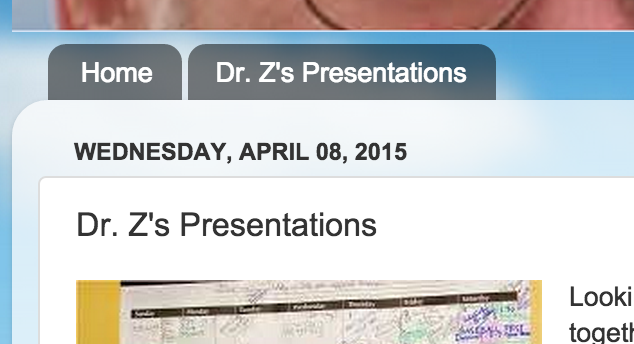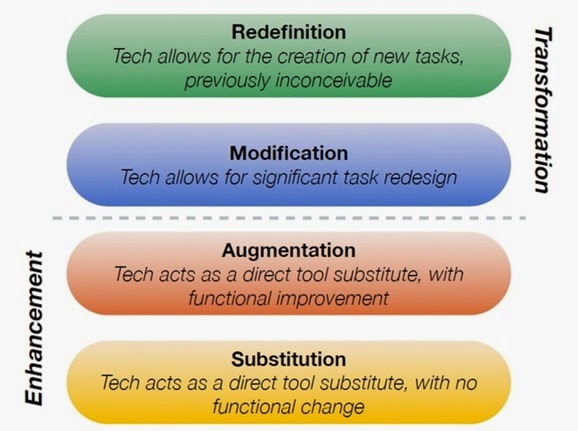Pages
Monday, July 06, 2015
Tuesday, June 30, 2015
Rube Goldberg Leads Our 6th Grade Students through STEM at ISTE
Join the Rube Goldberg Learning Community
Based upon the discussion at the end of our ISTE session, I have created a Google Doc where you can add your ideas and examples about how to engage Rube Goldberg problems in learning.

How do we teach STEM using exciting and crazy devices like Rube Goldberg Inventions?
Today I have the opportunity to share my ideas and experiences with doing just that. I will begin by introducing the facets of STEM education along with 8 essential elements for Problem-Based Learning which is the basis of effective STEM education.
Here are some of the materials I used and the resources I have consulted for this presentation. Some of the materials I will be covering are also covered in previous Dr. Z Reflects postings so you will find some links at the bottom of this post.
Rube Goldberg-Related Resources:
- Videos - Shown before the presentation.
- Invent Tomorrow Links - List of the links I used sharing Rube Goldberg resources.
- Rube Goldberg Ideas video - List of videos that you can use to give your students ideas about the simple machines that create an invention.
- Video version of this lecture at K-12 Online Conference - This is a 20-minute version of this presentation that I submitted to the K-12 Online Conference.
- Teaching STEM Elements Using Rube Goldberg Inventions Powerpoint slideshow
- Nationalacademies - STEM Integration in K-12 Education - GREAT 4 minute video!!
- StemAdvantage.org - Good source for STEM Stats
- TeachThought - Incredible Education Blog
- Difference between Projects and Project-Based Learning
- Buck Institute for Education - Leading resource for Problem-Based Learning
- Rube Goldberg Inc. - The company that supports Rube Goldberg projects.
- Purdue University 2014 Rube Goldberg Winners - See how University students create "Complex Chain Reactions to Achieve Simple Tasks."
Are Your Educational Games Actually Worksheets with Points? Here are 6 ways to Find Better Learning Games
I was just reading Cool Cat Teacher when I saw this posting. It is an interesting topic but it was more interesting when I realized that I spent the last couple of days with the author, Kae Novak, here at ISTE. She really knows gaming and I am learning a great deal as I work with the ISTE Gamers. I will be movinging forward with introducing gaming into my fall classes and I am learning A LOT.
You should go the the full posting at Cool Cat Teacher to read the rest of the discussion.
Pedagogical Tips on Gaming Successfully in the Classroom.
- Understand what makes a good game.
- Become a Game Master.
- Find good games.
- Learning best practices.
- Connect with other teachers using games.
- Consider how games can teach more.
You should go the the full posting at Cool Cat Teacher to read the rest of the discussion.
Monday, June 15, 2015
4 Fundamental Problems With Everything You Hear About the Future of Education
 |
| Jordan Shapiro |
This morning I read an article in Forbes by Jordan Shapiro. This article, 4 Fundamental Problems with Everything You Hear About the Future of Education, included some insightful comments that I would like to share with you here. Below, I have listed the 4 myths that Shapiro enumerated along with some of my own narrative. I strongly suggest that you read the whole article connected to the link above to get the full flavor of the message.
- Kids are bored and technology will provide better ways to engage students. - I agree with Shapiro when he says that it is about the teacher, not the technology. Unfortunately, the biggest barrier I have with the future teachers that I teach is that many of them have the belief that we need to integrate technology for technology's sake. Not the case. Technology can provide opportunities for learning that would not be otherwise available but it can still be used badly. We can use video conferencing to connect 6th grade classrooms in different countries but if their activities are limited to teacher-led worksheet filling-out, there is little value.
- More data-based adaptive technologies will lead to child-centered curricula. - Intelligent tutorials are useful devices in building skills, but they aren't the answer to building child-centered curricula. If you have a skillset that your students need to learn, it has been shown that students can learn faster using adaptive technologies. BUT the key is how these skills will be applied. This can't be done using data-based adaptive technologies. Problem-based learning can provide the valuable learning experience that students can have when applying those skills.
- Video games will finally contextualize academic content - Video games can present problems in a context but does that necessarily align with the real world? When learners play "against the machine", they learn in the the context that the programmers provided. When learners play against each other in a game like Civilization, they are provided a context within which they are working with other people. The game provides the playing field and the contestants provide the human emotions and decision-making processes from which they will learn. Experiencing the actual decision-making process that a person will undergo when negotiating a treaty or deciding about attacking a fortress can provide insight that couldn't be learned from a book. When students have these experiences together, they can come to class and discuss their feelings and learn more about what historical figures might have done.
- Learning should be more fun. - Shapiro points out that learning is NOT fun. Learning is an experience where you are stretched. It is a situation where you are drawn from your comfort zone and expected to succeed. Can this happen in games? - Yes. Is this necessarily fun? - No. It is challenging. Being challenged and having a safety net so that you can try new things without the chance for a huge loss can provide a sense of accomplishment but it doesn't need to be fun.
While you can see that Shapiro and I don't see eye-to-eye on everything, you should read his article. It has a lot of good points in it.
I just downloaded the .pdf of his book, The Mindshift Guide to Digital Games and Learning. I haven't read it yet, but look forward to experiencing his advice.
What do you think about these points? Please provide a third-leg to our discussion.
Z
Monday, June 08, 2015
Are YOU a Helicopter Professor/Teacher?
 |
What do you do when you decide to move from "Sage on the Stage" to "Guide on the Side?" Typically, you spend a GREAT deal of time setting things up so that you can create a learning environment where students learn by researching and doing new ideas instead of listening to you telling them these ideas.
A part of being a Guide on the Side is that you may feel like a 3rd wheel while you watch your students work together in class. It's ironic that the best way for your students to learn can be to learn on their own with you "out of the loop." You may not be directly involved in their learning experience, but you are guiding them through the learning process. You are taking a different role in the classroom.
This is an example of Teacher Lead - Student Driven
I just read an article in Faculty Focus where Berlin Fang is suggesting ideas that will provide your students with the "proper balance of challenge and support."
Six Suggestions on How to Avoid being a Helicopter Professor
- Allow Chaos
- Embrace Desirable Difficulty
- Increase Accountability
- Reduce Redundancy
- Remove Crutches
- Mix Push and Pull
Dr. Fang introduces some interesting concepts in these 6 suggestions. He discusses Free-Range Assignments that are individualized competency-based challenges. He suggests that we should help students but don't teach helplessness. This sense of self-efficacy is accomplished by starting with scaffolds to support new learners, but methodically removing them so that students can learn to stand on their own.
What do YOU think? Did that article hit the button with you or are you still a Helicopter Educator?
Photo: Mark Ludy
Tuesday, April 28, 2015
Kids Give Tips on Writing Quality Comments on a Blog
Here are some quality tips on how to write quality comments on a blog that you just read. I learned a lot. Maybe this will be useful for you and your students.
Monday, April 20, 2015
Finding the Speed of Light with Peeps - Science Experiment
Yes, I know that this is different than the typical discussion on Dr. Z Reflects, but I just had to share this wonderful science experiment.
This 5-minute video shares a wonderful demonstration of applied mathematics and science. Using a tray full of peeps, you can actually demonstrate how wavelengths move across a microwave.
The experimenter (couldn't find his name in the credits) places a tray of marshmallow peeps into a microwave and turns it on for a couple of minutes. He pulls it out and then looks for the specific places where the peeps have really melted. These places are about 2.4 inches apart. Based upon the assumption that the microwaves are melting the peeps in places where the wave actually travels through the peeps, it is possible to use these calculations to compute the speed of light.
I can see 10 year old students doing this and suddenly having a realization light going off in their heads by this demonstration. This is a MUST WATCH video and MUST IMPLEMENT in your classroom.
This 5-minute video shares a wonderful demonstration of applied mathematics and science. Using a tray full of peeps, you can actually demonstrate how wavelengths move across a microwave.
The experimenter (couldn't find his name in the credits) places a tray of marshmallow peeps into a microwave and turns it on for a couple of minutes. He pulls it out and then looks for the specific places where the peeps have really melted. These places are about 2.4 inches apart. Based upon the assumption that the microwaves are melting the peeps in places where the wave actually travels through the peeps, it is possible to use these calculations to compute the speed of light.
I can see 10 year old students doing this and suddenly having a realization light going off in their heads by this demonstration. This is a MUST WATCH video and MUST IMPLEMENT in your classroom.
Friday, April 17, 2015
Another Rube Goldberg STEM Session at UNI Elementary Literacy Conference
How Rube Goldberg Led Our 6th Grade Students to Pursue their Passions - UNI Elem Lit Conf from Leigh Zeitz
That's a good question. I have been invited to share our Rube Goldberg experiences as a Featured Speaker at the UNI Elementary Literacy Conference.
Interestingly enough, I will be sharing the stage with Dr. Beth Van Meeteren (STEM in PreK-3rd Grades: A Reason to Develop Literacy); Marcy Seavey (Finding the Citizen Scientist in Every Child); and Rick Vanderwall (Media and Drama Integration with Literacy) It will be an exciting opportunity for all.
Today I will be sharing our Rube Goldberg experiences in the 6th Grade Waverly-Shell Rock Middle School. We will discuss the explorational process that we experienced while creating our own inventions to accomplish simple tasks. These tasks might be turning off a light, erasing a blackboard, or popping a balloon. These may seem like meaningless tasks, but its not about turning out a light. The emphasis of this process is the creative problem solving that our students experienced while they were building these inventions.
If you want to learn more about my presentation, you can refer to my other posts in DrZReflects. The Slide Show is available in the list below as well as some of the other resources that I used in preparation.
- UNI Elementary Literacy Conference.
- UNI Teaching STEM Elements Using Rube Goldberg Inventions Powerpoint slideshow
- Invent Tomorrow Links - List of the links I used sharing Rube Goldberg resources.
- Rube Goldberg Inc.
- Purdue University 2014 Rube Goldberg Winners
- Rube Goldberg Ideas video
STEM
- Nationalacademies - STEM Integration in K-12 Education - GREAT 4 minute video!!
- StemAdvantage.org - Good source for STEM Stats
- TeachThought - Incredible Education Blog
- Difference between Projects and Project-Based Learning
- Buck Institute for Education - Leading resource for Problem-Based Learning
Do you have more resources you want to share? Please add them to the comments below.
Z
Tuesday, April 14, 2015
Use These 4 Videos When Developing Project-Based Learning
Project-Based Learning is not an easy way to teach but it is much more rewarding for the learners and the teachers. Here are some must-watch videos about Developing Project-Based Learning. I have tried to share them in a progressive sequence that you can use to move through the process of learning about and through PBL.
Project-Based Learning: Explained
Looking for an easy introduction to PBL? This Common Craft video developed for the Buck Institute for Education does a good job of describing PBL and how it fits into 21st Century Curriculum. An interesting part is that they only talk about 3 of the 4 Cs (Communication, Collaboration and Critical Thinking). I wonder what they did with the fourth C, Creativity?
The Five Keys to Project-Based Learning
Well-designed PBL has been shown to result in deeper learning and more engaged, self-directed learners. This video provides a suggestion for five core elements of successful PBL. Here are more resources at Edutopia where you can learn more about PBL.Meeting the Challenges of Project-Based Learning
Introducing PBL into your class isn't an easy process. This video shares the difficulties and triumphs of Sammamish High School (Washington) teachers as they move from traditional teaching to schoolwide problem-based learning.Assessment in Project-Based Learning
This 30-minute webinar explores how PBL might be assessed with the BIE Editor-in-Chief, John Larmer, and a team of educators.Project-Based Learning is the epitome of 21st Century Learning.
How are you using it? What additional resources do you need to make it a reality in your teaching?
Z
Thursday, April 09, 2015
Teaching STEM Elements Using Rube Goldberg Inventions
How do we teach STEM using exciting and crazy devices like Rube Goldberg Inventions?
Today I have the opportunity to share my ideas and experiences with doing just that. I will begin by introducing the facets of STEM education along with 8 essential elements for Problem-Based Learning which is the basis of effective STEM education.
Here are some of the materials I used and the resources I have consulted for this presentation. Some of the materials I will be covering are also covered in previous Dr. Z Reflects postings so you will find some links at the bottom of this post.
Today I have the opportunity to share my ideas and experiences with doing just that. I will begin by introducing the facets of STEM education along with 8 essential elements for Problem-Based Learning which is the basis of effective STEM education.
Here are some of the materials I used and the resources I have consulted for this presentation. Some of the materials I will be covering are also covered in previous Dr. Z Reflects postings so you will find some links at the bottom of this post.
Rube Goldberg-Related Resources:
- 2015 Statewide Teaching and Learning Conference
- Teaching STEM Elements Using Rube Goldberg Inventions Powerpoint slideshow
- Nationalacademies - STEM Integration in K-12 Education - GREAT 4 minute video!!
- StemAdvantage.org - Good source for STEM Stats
- TeachThought - Incredible Education Blog
- Difference between Projects and Project-Based Learning
- Buck Institute for Education - Leading resource for Problem-Based Learning
- Rube Goldberg Inc.
- Purdue University 2014 Rube Goldberg Winners
- Invent Tomorrow Links - List of the links I used sharing Rube Goldberg resources.
- Rube Goldberg Ideas video
Wednesday, April 08, 2015
Dr. Z's Presentations
Looking for an opportunity to get together?
I would love to have a chance to talk with you face-to-face and share your successes. Sometimes it seems like this blog is too much one way.
Over the next few months, I will be speaking throughout Iowa and even visiting Philadelphia for the ISTE conference. I decided to create a page on this blog where you can see my engagements (and more importantly, where I can see my own engagements.) =-)
You can access this page by clicking on this phrase or by clicking the tab below our Dr. Z Reflects Blog heading.
I would love to have a chance to talk with you face-to-face and share your successes. Sometimes it seems like this blog is too much one way.
Over the next few months, I will be speaking throughout Iowa and even visiting Philadelphia for the ISTE conference. I decided to create a page on this blog where you can see my engagements (and more importantly, where I can see my own engagements.) =-)
You can access this page by clicking on this phrase or by clicking the tab below our Dr. Z Reflects Blog heading.
Thursday, March 26, 2015
Are You Looking for REAL Feedback as a Teacher? - TED TALKS
I just watched this TED Talk by Bill Gates. He is talking about teachers recording themselves and receiving feedback on their teaching through placing a flip camera on a tripod in the back of their rooms and then just watching it themselves and beginning by being their own coaches. You know, I am teaching all of my classes online this semester and am recording all of the sessions. I have expected students to review the videos if they miss them, but maybe I should review them as well to see how well I am doing . . .
What do you do to get feedback on how you teach?
Friday, March 20, 2015
5 Word Clouds Reveal What ISTE Standards Emphasize
Recently I was preparing for teaching my course, Leading Change Through Instructional Technology. As I was reviewing the ISTE Standards, I became interested in looking for the emphases in each of the areas identified by these standards. It was quite obvious that addressing the teacher standards would prepare Teachers for creating a learning environment where Students could learn in a 21st Century manner. The Administrators were envisioning and providing schools where teachers could create such learning environments. The Coaches were training Teachers to use the 21st Century Skills to create these learning environments.
While reading these standards, I took notice of the language used in each of them. I decided that the best way to look for linguistic structure and commonalities was by drawing Word Clouds. I ran each of the standards through Wordle.net and they yielded the images below. Review them briefly and identify look for the dominant words in each of the clouds. Remember that the larger the word, the greater the number of times that word appeared in each standard.
It is encouraging to see that Learning is the largest word in each of the first three clouds. The Teacher's second largest word is Students. Technology is the second largest in the Administrator and Coach standards. Look at these clouds identify the what's important in each of these standards.
 |
| ISTE Standards for Teachers |
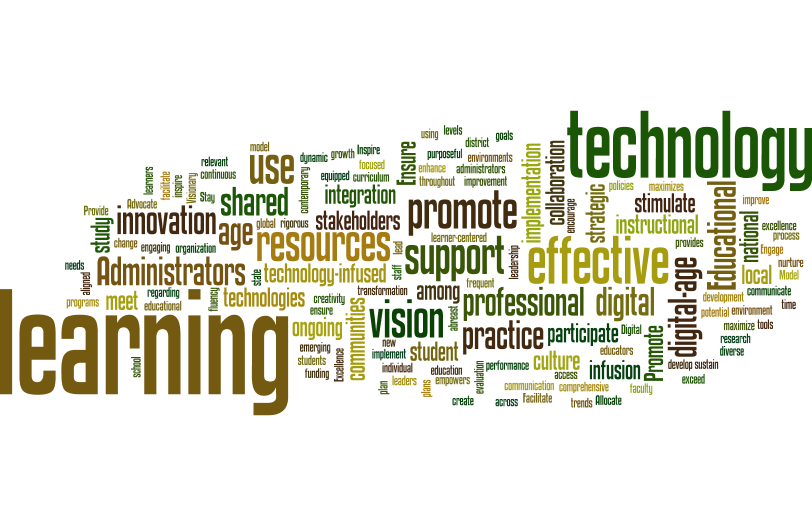 |
| ISTE Standards for Administrators |
 |
| ISTE Standards for Coaches |
As I reviewed the Students cloud, it was interesting to see that Learning is not even included in their cloud. That is strange since the only thing the students are assigned to do is Learning. Information is the main word for the students. That is what the students need to manage. Look a little closer and you will see that the action verbs including Use, Analyze, Solve and Develop are some of the larger words in the cloud. These are the measurable behaviors that will indicate that learning has occurred.
 |
| ISTE Standards for Students |
Thursday, March 05, 2015
Alan Kay - Invents the Future
Alan Kay is one of my heros. He was one of the earliest pioneers in Object-Oriented Programming, personal computing and graphical user interface. Dr. Kay has had a productive life where he was part of the Xerox PARC where they developed an entire genre of personal computing that was later used to create the Macintosh.
I have always tried to live by his motto:
I have always tried to live by his motto:
The Best Way to Predict the Future is to Create It!
Here are a couple of videos done recorded by Bob Greenberg. He has been recording leaders in the field and has more than 120 recordings at his Brainwaves site.
Monday, March 02, 2015
10 Ways to Get Teachers to Embrace Technology
 |
| BodyGuardCareers.com |
I was pleased to see that ExitTicket's suggestion for 10 Ways to Get Teachers Using Tech. While this is ExitTicket's move to try to induce change in schools to use their product (and they include the disclaimer in their posting) I would suggest that you read and consider these ideas to bring about change in your schools.
I am listing these 10 ways, but I would suggest that you visit ExitTicket's original site to learn about the particulars for each of these ideas:
- Ban Alternatives for a Week.
- Devote Time to Adding Content.
- Designate an Ambassador.
- Share Student Voices.
- Preserve Existing Routines. (at first)
- Put Resources in a Clean Package.
- Sync Your Account.
- Separate Initial Goals from Long-Term Goals.
- Tech Tuesday.
- Make It Fun.
Read through these and try them out. I can't wait to hear about your successes and challenges in making this happen.
Z
Saturday, February 28, 2015
Goodbye Mr. Nimoy
I am sorry to hear that Leonard Nimoy has left this dimension to Boldly Go Where No Man Has Gone Before. You can see that my family and I played roles in an episode with Spock and Kirk. (I am the vulcan on the left side.)
Monday, February 23, 2015
Using Technology vs Technology Integration - The Difference Defines Success
One of the toughest parts about leading educators toward using technology to engage learning is getting past talking about using technology for the sake of using technology to using technology to engage learning.
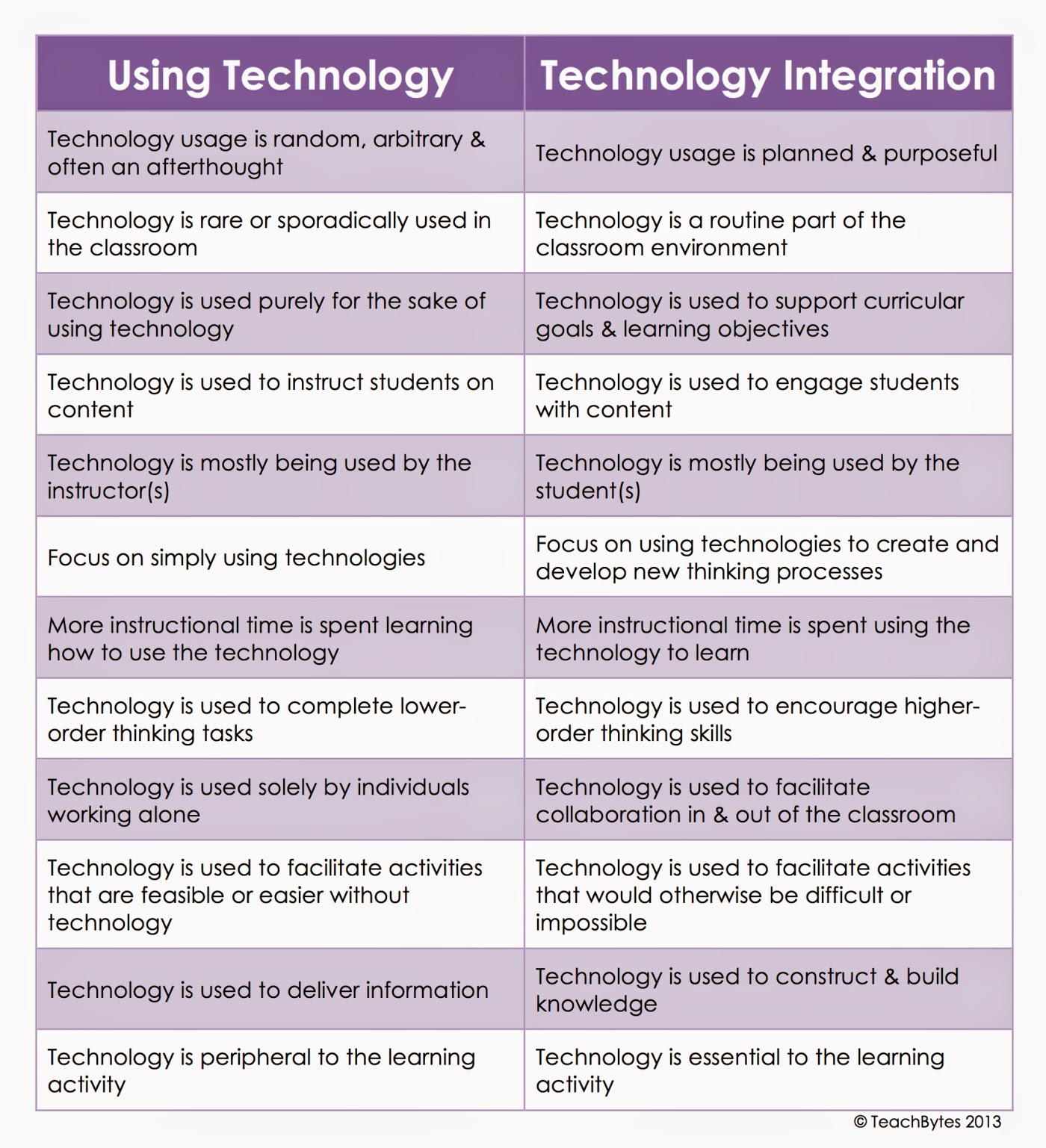 |
| Click the table to enlarge it to read it. |
I was intrigued when I found the table below on Clif Mims' paper.li publication, Clif's Notes on #Edtech. (It was actually created by ADITI RAO and published on Teachbytes.com) The beauty of using the table below, is that it provides a vocabulary that we can use when we discuss how to use technology with our colleagues.
Where does your curriculum lie in this table?
Technology Integration Matrix
There are other important tools that provide vocabulary for using technology to engage learning. There is the Technology Integration Matrix (TIM) which provides a system of 25 cells that have 5 columns headed with terms identifying the Levels of Tech Integration (complexity of technology use/level of student centricity) across the top and down the left side are 5 Characteristics of a Learning Environment. The beauty of this matrix is that provides a system that you can use to identify where you are in a lesson/activity you are teaching and then suggestions for how you can increase your level of Technology Integration. Both the Original Florida version and the Arizona versions have videos and lesson plans for creating these learning environments. I have included a more complete description of these tools in another posting, Building Learning Through Technology. Based upon the TIM matrix, I would say that most of the previous chart's activities in the left column involve Entry and Adoption while the right column describes Adaption, Infusion and Transformation. What do you think?
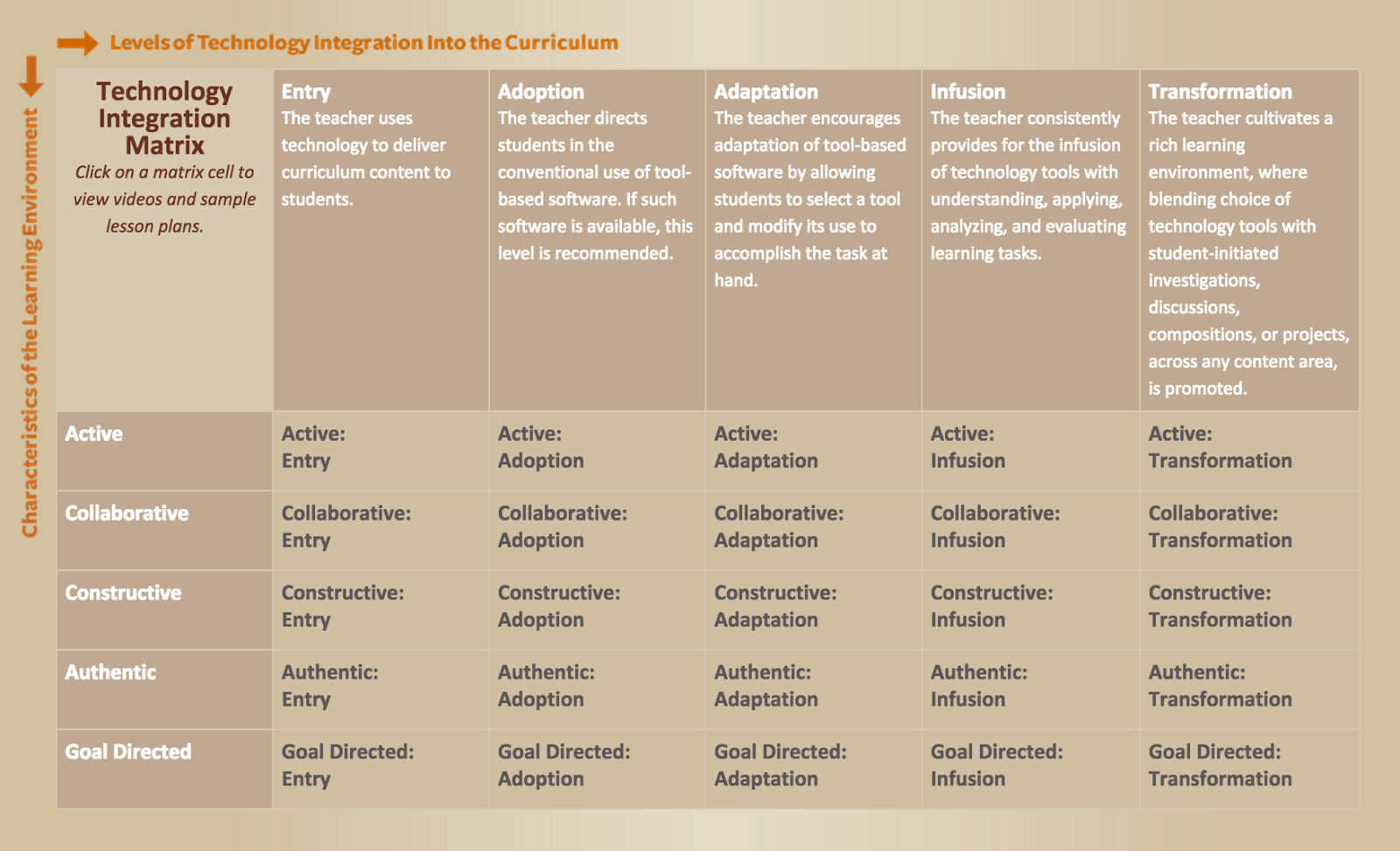 |
| Click the table to enlarge it to read it. |
SAMR (Substitution-Augmentation-Modification-Redefinition)
You may not have heard about the TIM, but you have been using SAMR in your schools. This is another ?? for defining Technology Integration. Developed by Ruben R. Puentedura, Ph.D. to describe a ladder of implementation, this four-stage hierarchy considers the bottom two levels to be forms of Enhancement and the top two levels in the class of Transformation. While the students' role in the learning process is implied in the SAMR, I must admit that I like the TIM better because it specifically defines the changing roles of the students in the pedagogical process.
JUST IN: As I was writing this, I discovered another relevant graphic on FaceBook (yes, sometimes I veer off into FaceBook when I am looking for inspiration ;-) This is another graphic that fits the role of identifying how we want students to use technology. In this case, I would say that the Wrong column includes Adoption and Adaptation in the TIM matrix and the Right answers may fit in the Infusion and Transformation columns with some of them not even fitting on the matrix but including things that we want to see in education, (i.e., Start Conversations.) What do you think?
The final quote, "Technology is a Tool, NOT a Learning Outcome," encapsulates this whole posting. Technology is not an end unto itself - it is a means to an end that will hopefully lead to empowered and active learners.
BTW, This graphic is created by Bill Ferriter who writes a blog entitled The Tempered Radical. I am glad that I found this blog because it appears that Bill is an aware teacher who is interested in sharing what he sees and providing interested insight into how schools work and how they can be improved. One of the things that I noticed throughout his blog is that Bill appears to be creating his graphics (like the one below) by drawing it on paper and then scanning it. That is artistic and is not something that we see too much anymore.
So what do you think?
Is this something that you can use when you are working with your teachers, administrators and students? What do you see as you look around your curriculum? Where does it fit on the TIM or SAMR?
What can you do to "Take it Up a Notch?"
Z
Subscribe to:
Posts (Atom)





